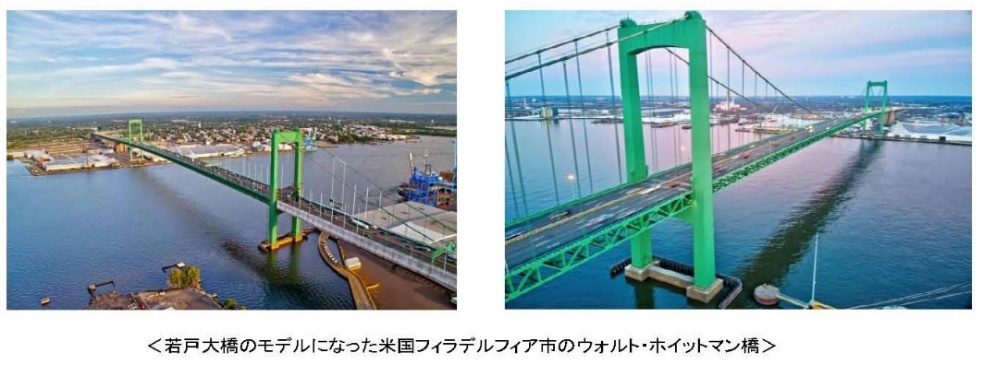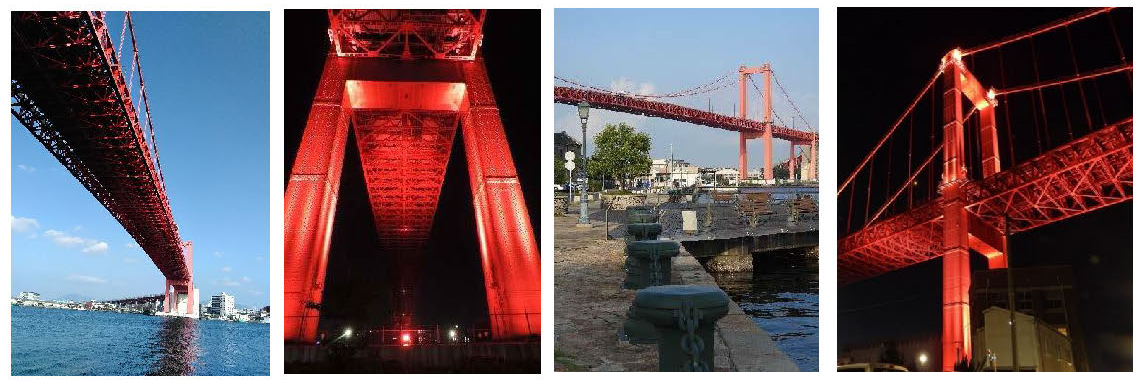The Origin of “Great Bridge Building Era” Across the Japanese Archipelago
~ The Dream of Merger of Five Municipalities Entrusted to the Red Bridge ~
Feature PICK UP 若松トピックス

The Wakato Bridge connecting Wakamatsu and Tobata across Dokai Bay opened on September 26, 1962. This 627-meter-long bridge with a 367-meter center span broke several of Japan’s bridge construction records and was highly esteemed as “the number one suspension bridge in the Orient.” This project, which is said to have involved a cumulative total of 600,000 people, adopted the most advanced technologies of the time and took three-odd years to complete.
Some sixty years since it opened, the red bridge is now an integral part of the cityscape. It was designated as a nationally important cultural property in February 2022, and its architectural value has been reevaluated. Since there was no AI to take advantage of, the strain of the bridge was measured by using light refractions to address wind load and cable production issues arising as suspension bridges became larger and longer. The technologies used for the construction of the Wakato Bridge had a significant influence on Japan’s large-scale bridge construction methods.
Tortuous Route Before the Construction of the Wakato Bridge
At the end of the 19th century, when coal production increased along with railroad expansion, a first-in-Japan small steamboat was put into service in Dokai Bay. Thereafter, in the early 20th century, coal shipments rapidly increased and the capacity of heavy industry, including ironworks, expanded. As a result of the dramatically increased boat traffic in Dokai Bay, marine accidents became frequent occurrences. The records show as many as 1450 accidents occurring during the ten years from 1926 to 1935.
Among other incidents, the capsizing of the Dai-Ichi Wakatomaru in 1930 and the large number of victims involved caused widespread shock. The sea was rough with strong winds on the day of the accident and passengers well exceeded the ship’s capacity, as the popular Ebisu Festival was being held. The ferry capsized near the Wakamatsu-side quay wall and claimed 180 victims, including 73 who died. This spurred the development of the Wakato undersea tunnel plan to safely connect Wakamatsu and Tobata.
While the project was being considered, Japan’s first car ferries, the Dai-Hachi Wakatomaru and Dai-Kyu Wakatomaru, were placed in service, further aggravating the congestion in Dokai Bay. The daily average passengers in Dokai Bay on Wakato ferries totaled 27,000, with rough 700 vehicles carried on an average day.
In addition, while heavy industry was booming, the number of ships coming in and out of Dokai Bay became the greatest in Japan, and cargo dramatically increased to make it the third largest port in Japan in volume. Dokai Bay was designated as a special major port of Japan. The cargo ships and Wakato ferries closely navigating past one another in the narrow bay presented extremely dangerous circumstances and renewed interest in the undersea tunnel plan, which was invigorated again in 1936.
Two years later, a plan to abolish Wakato ferries and replace them with an undersea tunnel was proposed by local entities and Fukuoka’s prefectural government. With approval obtained from the Minister of Home Affairs, the plan became a five-year project. However, due to the expansion of the Sino-Japanese War and imminent outbreak of the Pacific War, the commencement of construction was shelved and the project came to a halt.
After the Pacific War, the war that broke out in the Korean Peninsula caused cargo traffic in Dokai Bay to become very active. The Wakato undersea tunnel plan, coupled with the idea of merging five municipalities, came to draw attention again. In 1952, a basic geological survey of Dokai Bay was conducted and an opinion was presented that the construction of a bridge as well as an undersea tunnel was feasible.
As a result, a comprehensive study was conducted to examine technical issues and the discussion turned sharply toward bridge construction. Factors considered behind this trend would have included the challenging construction of a suspension bridge with a long center span, the smooth supply of steel materials expected from the adjacent Yahata Steel Works, and an attractive appearance to serve as a symbol of the merger of five municipalities.
National Route 199 (Moji Ward–Yahatanishi Ward) was designated and, in April 1959, the construction of a large and long suspension bridge by the Japan Highway Public Corporation at a site straddling Dokai Bay was slated to proceed.

The Wakato Bridge Is Modeled on a Large and Long Suspension Bridge in the U.S.
The Wakato Bridge, completed on September 26, 1962, comprises a roughly 2.1 km roadway with a 367-meter center span and 627-meter suspended section. The bridge girder hovers 40 meters above the high-tide sea surface level to allow for the movement of large cargo ships. Based on an estimation that 3000 vehicles would cross per day at the time of opening, with a forecast of that increasing to 6,000 vehicles 20 years later, the bridge was built with a 9-meter-wide roadway and a 3-meter-wide sidewalk on each side for shared use by pedestrians, cyclists, and others. Four elevators were provided at the anchorages at both ends.
The total project cost 5.1 billion yen (at that time), and roughly 20, 000 tons of domestically produced steel were used. The name, Wakato Bridge, was selected from roughly 34,000 suggested names. The color of the bridge, said to have been selected by the Wakato Aesthetic Appreciation Committee, was made red to symbolize dignity, energy, passion and mission. It is also the color of rust-proof paint and shows up more beautifully against the background of surrounding sea, sky and mountains.
When it comes to large and long suspension bridges of that era, we may tend to recall such bridges as the Brooklyn Bridge and Golden Gate Bridge in the U.S. However, the Wakato Bridge was modeled on the Walt Whitman Bridge in Philadelphia, built in 1957. This bridge is 3,652 meters in total length and, like the Wakato Bridge, connects two industrial towns.

The Wakato Bridge was Designated as a Nationally Important Cultural Property.
In the 80s, vehicle traffic on the Wakato Bridge significantly exceeded the figure initially projected at the time of construction, with annual traffic in 1982 exceeding 12 million and the daily average reaching roughly 34,000 vehicles. In response to the Fukuoka Prefecture Highway Council’s proposal on increasing the traffic lanes from two to four, roadway width expansion work, which necessitated the elimination of sidewalks, was conducted. This expansion to four lanes cost 17.5 billion yen (at that time) and was completed in March 1990. The Wakato Bridge and Kitakyushu Expressway were also directly connected by the project.
Control over the Wakato Bridge was transferred from the Kitakyushu City Government to the Kitakyushu City Road Public Corporation, and the bridge toll was reduced based on the premise of consolidated management of the bridge and Wakato Tunnel (Shin-Wakato Road). In September 2012, the Wakato Tunnel was opened to traffic. On the Wakato Bridge, large-scale repair work was completed and a commemoration ceremony was held to celebrate its 50th anniversary. In April of the following year, an exhibition hall called “Aviewred Bridgeum” was opened in the Wakamatsu-side anchorage for group visitors from schools and workshops.
On December 1, 2018, the Wakato Bridge and Wakato Tunnel became toll free, rewarding the fervent desire of Wakamatsu Ward residents. Transitions in vehicle traffic by year from 2012 to 2018 show that it exceeded 16 million vehicles a year (a daily average of 45,000 vehicles). Thus, the bridge and tunnel became a large artery in reality and in name, directly connecting the Wakamatsu area and downtown Kokura.
Thereafter, the Council for Cultural Affairs highly evaluated the Wakato Bridge in terms of its influence on large and long suspension bridge construction projects in Japan and its historical significance, in addition to the innovative technological methods employed based on scrupulous survey and research, and recommended its designation as a nationally important cultural property to the Minister of Education, Culture, Sports, Science and Technology. On February 9, 2022, the Wakato Bridge was thus designated as a nationally important cultural property (building).

Hope Entrusted to the Wakato Bridge Remains Unchanged Today.
For more than sixty years since it opened, the Wakato Bridge has been a major artery that has supported regional development and has served as the symbol of Wakamatsu. The pride that the citizens have in the Wakato Bridge remains unchanged to this day.
The round-table discussion of the mayors of the five Kitakyushu municipalities held in May 1961 showed that they had great expectations for the Wakato Bridge as a tourism resource in “A Million Person City – Kitakyushu City” to be born by the merger. They suggested some tour plans to connect sightseeing in the five municipalities via a single line, such as one-day course to look at the Wakato Bridge from underneath aboard a modern speedboat or hydrofoil, with a run across the Dokai Bay and the Kanmon area, with sightseeing on land combined. They also suggested courses of industrial tourism via the sea.
To develop such ideas and enhance the region’s attraction as a tourist venue, it would be necessary to make a tourism resource of the modern history that took place under the Wakato Bridge, such as that covering the rise and fall of the coal industry, restoration projects of Dokai Bay that addressed the problem of the bay once having turned into a “sea of death,” and reinvigorating local festivals and events as tourism resource.
It will also be necessary to learn extensively from successful port tourism examples both inside and outside Japan and to build a system to develop a progressive approach. New investments to complement tourism resources in the region are needed for the promotion of tourism for the entire city of Kitakyushu. A possible example may be to construct a museum covering Japan’s large and long suspension bridges on the south coast of Wakamatsu, which lacks significant sightseeing resources, by making use of name recognition of the Wakato Bridge, a nationally important cultural property.
※ History of Wakato Bridge https://www.city.kitakyushu.lg.jp/contents/05500121.html
※ National Important Cultural Property Designation Commemorative Wakato Ohashi Virtual Tour Main Tower https://www.youtube.com/watch?v=Fb3xp2HBKys








